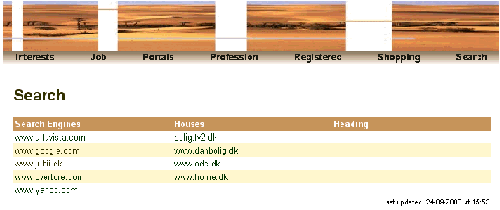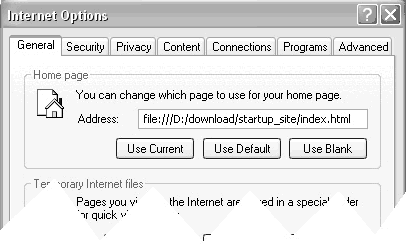Using a Startup Page
This article explains the idea of using a locally stored HTML page with favorite links as Startup page in an Internet browser. Suggestions for how to create such a page are also presented.
Background
The truth of the matter is that I did not come up with the idea of using a local Startup page myself. I got it from a colleague in 1998 or 1999. Since then I have refined it and consider it an integral part in the configuration of my computer.
Last year, being 2002, I took it a step further and created a local web site, as the amount of links had become too numerous for a single page. Alternatively, I had to accept having to scroll down, which I did not.
In its current form my Startup site contains a main page with seven sub-pages. Each sub-page has one or more tables containing links organized under different headings. To some of the links I have added descriptive Title text which, for example, shows membership details and passwords.
|
Note:
|
Title text is an HTML attribute used for describing links. It must be supported by the browser to be displayed.
|
The figure below shows the Search sub-page from my Startup site. Click it to view a larger version.
 |
|
Search sub-page from my Startup site
|
Advantages
To me there are only advantages to using a local Startup page. Some of these are listed below.
- It brings down the time it takes the browser to launch and it enables direct access to favorite web sites.
I know favorite link functionality is already provided by most browsers. When, however, a browser is launched it begins with accessing a page on the Internet. This can be annoying if the page is not the one to visit. If, in addition, Internet access is done through a low-speed modem dial-up connection, then it may feel like a waste of time to access one site only to select another. It is, of course, possible to stop the loading of the site and enter the desired link.
- It removes the need for remembering to back up favorite links, if the page is stored together with work files.
Some browsers offer exporting and importing of favorite links to and from user-defined locations. This allows for back up of links, but unless they are exported regularly, the risk of losing them due to a crash or a virus is very real.
- It does away with the waste of screen estate, as showing a favorite links column becomes unnecessary.
With a local Startup page the links are reached by clicking the Home button.
Suggestions for How to Create the Page
One way of creating a Startup page is to use a word processor and to save the page as an HTML page. Alternatively, a spreadsheet can also be used.
Another approach is to use a web design tool such as GoLive, FrontPage, Dreamweaver or similar. These all give added control, present the layout in a graphical environment, and allow for implementation of advanced features.
Thirdly, the page can be written directly as HTML code in an ASCII-based editor and saved using the HTML-extension. One example of such an editor is Notepad.
A major disadvantage of this approach is that it requires HTML programming knowledge. On the other hand; once the page is created, using ASCII-based editors for direct editing of the HTML code is quite fast for minor corrections and can be learned quickly.
In this article I have chosen to use the first - the word processor.
Sample Implementation
This section shows how to make a Startup page containing links set up in a single column layout.
To create a Startup page
- Launch word processor.
- Enter the web addresses in a new document - one address per line.
|
 |
|
Entering web addresses
|
- Save document as a web page.
This should be to a safe location such as a work drive.
- Close word processor.
- Launch browser.
- Open the new web page.
- Access the browser properties.
In Internet Explorer these are found in Tools > Internet Options.
|
 |
|
Internet Options specifying Startup page in Internet Explorer
|
- Select the viewed page as new Startup page.
In Internet Explorer this is done by clicking the Use Current button.
- Accept the new browser properties and close the dialog box.
- Close the browser.
- Launch browser and check that the new Startup page is loaded.
Maintenance of the Startup page is carried out using the word processor.
Future Considerations
The amount of links that fits on a page using the single column layout is unlimited if scrolling is accepted. Instead of accepting this, the layout can be upgraded to multi-columns by use of a table. The number of links that fits on the page, before scrolling gets necessary, is then multiplied by a factor two, three or higher. This has the extra advantage that pre-defined table layouts can be applied to add effects.
Depending on the word processor used for creating the Startup page the produced HTML code can be more or less efficient. This is not a problem with the simple layouts suggested in this article. But as the desire for graphics and advanced effects begin to grow, it may be worth to begin using a web design tool instead.
